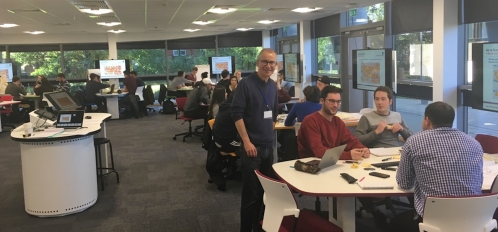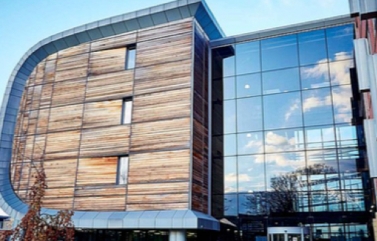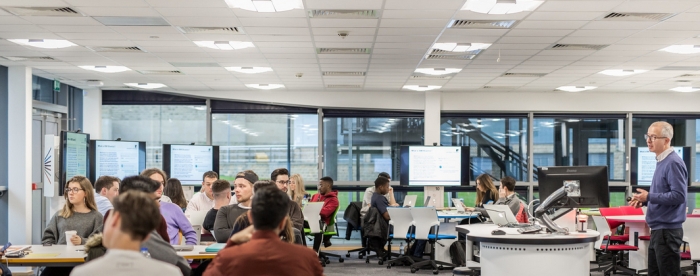
For the last three years the Royal Academy of Engineering (RAEng) has sponsored my Visiting Professorship (VP) in Innovation at the University of Leeds. As it’s been one of the most rewarding things I’ve ever done, I’ve written this blog to share the experience
The story starts in London, in a lecture room in UCL to be precise. I’d just given a seminar on innovation to a class of students for ex-IBM colleague, Distinguished Engineer, RAEng VP and all-round top person Hugh Varilly. Afterwards Hugh and I got chatting. He said something along the lines of, “If you like this university stuff, you should get involved in the RAEng VP scheme”. After this he put me in touch with RAEng Fellow Ian Nussey.
After a few testing questions, Ian encouraged me to apply. I had a very good existing relationship with the Business School in one of my local universities, the University of Leeds. Understandably though, the RAEng VP scheme had to be progressed through an Engineering Faculty. Prof Krsto Pandza in the Business School introduced me to the Dean of Engineering, Prof Peter Jimack.

Peter and I sat down and discussed where a potential VP could add value. This included working with undergraduates to hone their employability skills, which aligned very nicely with both the aims of the university and the requirements of the RAEng scheme.
We co-developed a submission to the RAEng for a VP appointment. This had a number of aspects, such as guest lectures and employability workshops. But to keep the blog “short” I’ll describe the main theme – the creation of a new module for final year undergraduates centred on innovation and employability skills.
As you may have guessed, we were successful! That’s when the real work started. At this stage I’d like to thank my old management team at IBM for their great support in letting me do this.

The VP appointment began in the academic year 2016/17. We gave the module a name – “Innovation Thinking and Practice”. Before we could create the detailed content, there was much hard graft to be done. The module had to pass stringent design criteria and go through a number of administrative hoops, sorry approval steps. As it counted towards students’ final degrees, I appreciate this had to be done properly.
We then hit a challenge. The university was looking to rationalise the number of modules, rather than increase them. Thankfully, guided by my academic champions, the University of Leeds team recognised the module was different, and agreed it should be added.
It combines students from multiple schools, particularly Computing students (from Engineering) and Business students into diverse teams. The focus is on practical employability skills and team-based learning. Perhaps most importantly of all, it’s riddled (perhaps not the best word to use!) with industry expertise. There’s obviously me, but we have fantastic support from a diverse range of industry experts and guest speakers. They all provide fantastic knowledge and insight. There are too many to thank individually but you all know who you are. You’ve all been brilliant, thank you!
Thankfully, the module was approved. I spent several months of Saturdays developing content – short sharp lectures followed by longer facilitated workshops, supplemented by out of class student and team-based working.
We opted to host the module in the Business School. The first run was in 2017/18 (Year 2 of my VP) and fully subscribed with 60 students. We got lucky. This timing coincided with the opening of a brand-new collaborative teaching space. The room has been great. I also needed a formally employed University academic member of staff to work with. Again, I struck gold. Dr Lena Jaspersen has been brilliant, and we’ve been ably supported by many others.

To ensure I could focus sufficiently on delivery, I reduced my IBM hours (thank you again IBM!). After an intensive semester, the student teams wowed our senior academic and industry guests (read more here). They then greatly pleased Lena and myself with their reflective papers, which was when I discovered what academics get up to behind the scenes, many hours of marking papers.
The module is about innovation, so we couldn’t stop there. For the second run in 2018/19 (Year 3 of my VP) Lena and I designed in a number of incremental improvements. We injected more industry expertise into the first few weeks of the module. As the module was full again, we added 12 extra student places to create two more teams. Facilitating a dozen parallel workshops took us to the limit but we managed it. Once again, the students were brilliant (read more here).
As my VP comes to its end, we’re making more changes. We’re extending the cohort to 120 students by running two parallel sessions, and we’re using some of the extra places to make the module accessible to students in many other subjects. Once again in 2019/20 the module is fully subscribed.
When a VP appointment ends, the RAEng want to know how a university will continue to gain value. In support of this, and because it’s something I want to do, I’ve applied for an ongoing part time position in the University and have been successful. RAEng VP appointments are about infusing industry experience into academia. My own has ended with me entering academia myself. I can hardly wait for the year ahead.
Once again, thanks to everyone for their support. This includes Hugh V, Iand N and everyone at RAEng, Peter, Krsto, Kerrie, Lena, Sanaz, Andy, Owen and many others in the University of Leeds, all our industry experts and of course the fantastic students. I’ve learned so much, and hope you’ve learned something too.

I’d like to finish with a few personal tips for anyone thinking of applying to become a VP in the RAEng or a similar scheme:
- Read the submission guidelines carefully and align with them – this sounds obvious but for example if the focus is on undergraduate employability, ensure you cover it
- Get advice from the sponsoring organisation and speak to existing and/or previous VP’s – every VP is different but making the effort to understand what’s worked and hasn’t worked in the past really does help
- Ensure you have the right level of sponsorship in the university – people who know the institution well and have influence there, so aim high – the academic champion(s) will be critical to the success of your VP appointment
- Partner with academic staff – you’ll learn a lot from each other – in addition they know the ropes, university processes and pitfalls to avoid
- Maximise teaching and face time with students – any VP role should be about student success in the end, so ensure they get the opportunity to benefit from your experience
- Go for it!
I hope this has been a useful and interesting read. If, in the future, you’re thinking of applying to be a VP get in touch. I’d be happy to have a chat.
Details of the Royal Academy of Engineering VP scheme can be found here.
And here’s a University webpage write up on the 2018/19 final presentations.
